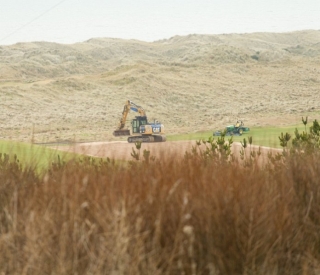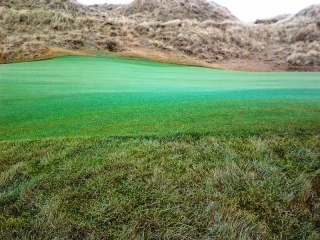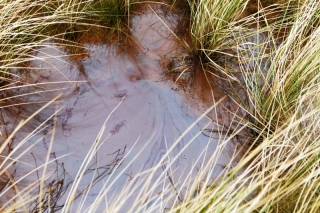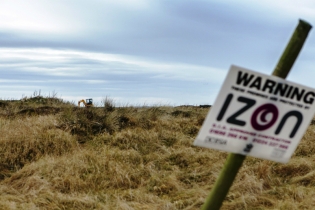In this instalment of the Menie Estate Series, Suzanne Kelly considers environmental issues and describes her visit to the course on 16 February 2013.
Our elected officials largely shrugged their collective shoulders when consigning the Menie Coastline and its SSSI sites to history to accommodate Trump International Golf Links Scotland.
It was Aberdeenshire Council’s position that making money outstripped the importance of the Scottish coastal environment for present and future generations of people and wildlife. They did phrase it a little less brashly than that:-
“Aberdeenshire Council supports the proposed development because the economic and social benefits through growing and diversifying the economy are sufficient to outweigh the conflict with national and development plan policies relating to the environment, protected landscapes and new house building.”
http://www.scotland.gov.uk/Resource/Doc/212607/0067709.pdf
At least a few gestures were made to protect whatever wildlife would survive comprising two 18-hole courses, clubhouse, parking, a 450-room hotel, 950 holiday apartments, 36 ‘golf villas’, 500 houses for sale, accommodation for 400 staff, and all the pollution this would bring.
An environmental advisory board, Menie (Links) Environmental Management Advisory Group, was appointed and Professor William Ritchie made its head. Professor Ritchie has been Director of the Aberdeen Institute for Coastal Science and Management at Aberdeen University since 2002, and he has a long list of credentials.
Surely this would be a pro-active group headed by an experienced leader who would do everything possible to safeguard our environment and enforce any environmental conditions on the site.
Professor Ritchie is listed in the Menie Estate Report to the Scottish Ministers as being ‘in support of the case for the development For Trump International Golf Links Scotland’. (http://www.scotland.gov.uk/Resource/Doc/212607/0067709.pdf)
Some would find this hard to credit – that an academic at Aberdeen University would prefer to see a golf course in place of two unique SSSIs which would inevitably be compromised. (Later on in the same report, Ritchie seems to say he is neither for nor against the planning application, which seems contradictory to the contents pages).
Despite claims in the report that Ritchie was on the Trump side of the argument, no doubt he would actively protect what could be protected through his role at the newly-created body, MEMAG.
MEMAG:
MEMAG holds meetings – which, according to minutes, the Trump organisation rarely sends representatives to attend :-
“The group noted that the absence of TIGLS representation at recent MEMAG meetings wasunfortunate but, on a positive note, contact had been made with John Bambury (JB) who is the new LINKS Superintendent.”
http://www.memag.org.uk/Docs/Minutes%20MEMAG%20-%2031May2012%20Website.pdf
Do MEMAG members visit the site regularly? Does MEMAG answer relevant questions in a timely fashion? Does it exercise its authority relevant to the following provisions made in the Report? Among other powers:-
“MEMAG has authority to prevent damaging activities…”
http://www.scotland.gov.uk/Resource/Doc/212607/0067709.pdf
MEMAG’s own mission statement reads in part:-
“to monitor environmental changes;
“to advise on good practice managerial responses;
“to act as an independent check that developer commitments in relation to the dunes environment would be fulfilled;
“to advise on mitigation and minimisation of environmental impacts; and
“to commence work before site work begins and to continue to advise throughout the operational life of the development.”
But like the sand dunes, things had shifted by the time MEMAG’s inaugural press release came out. MEMAG’s previous ‘authority to prevent damaging activities’ became:-
“For the avoidance of doubt, MEMAG operates as an advisory body only and will not have the power to veto any proposal or action proposed by TIGLS…”
http://www.memag.org.uk/Docs/MEMAG%20Press%20Relaease%201.4b%20Final.pdf
At the time of writing, MEMAG’s website had no minutes since June 2012, and has not responded to some dozen environmental questions it received from me on 23 January. Residents I have spoken with are not aware of having much or any contact with, or sight of MEMAG personnel visiting the site.
The following observations from my visit of 16 February should ideally be looked at by MEMAG, but perhaps it is time MEMAG itself should be looked at.
Digging the Scene
I walked the site for several hours on 16 February with an Aberdeen Voice photographer. There seemed to me to be work in progress without specific planning approval.
Retrospective permission has been sought after work is completed on this site before, such as for the gigantic earth bunds which block light near the Munro property.
Surely the environmental monitors would step in and halt any further unauthorised work?
At 11am on 16 February I observed three separate sites where earth moving equipment was in operation for work which had not been approved as far as I or the residents knew. Other vehicles on site included a digger parked near the Blairton Burn, which has permission for a bridge, as well as ever-circling IZON security vehicles visible several times on our walk.
The first work in progress is near the parking lot; a digger ( pictured top right ) is levelling out a large rectangular area. I wonder whether it could be for the temporary marquee, which is not yet approved.
Another earth-moving vehicle was digging; I cannot tell what the purpose was. This was on the west side of the course. Finally at the very south of the course a third vehicle was also digging. This might be the area set out for the second, as yet unapproved course.
This second course was announced with some fanfare in the press, but no plans are available for it yet on the council website, and in a phone call, Aberdeenshire Council confirmed they do not have the plans.
These possibly unauthorised works were reported to Aberdeenshire Council’s Planning Department by email and phone from 17 February. Although any unauthorised works can theoretically be stopped immediately, I have yet to receive word as to whether work has stopped, nor do I have any response yet from the council about this work.
The Blue, Blue Grass of Home
Like the pate of a certain bellicose billionaire, the greens of the first course seem to be thinning. In the first case, a subtle, unnoticeable comb-over hairstyle is the answer. In the case of the greens the answer is apparently – blue dye.
My visit on 16 February to the site was prompted by comments from a frequent Balmedie visitor: huge swathes of the green (and a little patch of sand) had been ‘spray-painted’ a blue-green colour.
Mother Nature seems not to be accepting the imposition of this golf course on the coast very well. First, part of the course was washed out to sea in winter storms.
Now the winds are blowing sand (hardly surprisingly) across the turfed areas, which can’t exactly be helping the grass to grow.
The height of the grass on some of the greens above the sand is very short indeed, making it seem that sand is covering the lower parts of the blades of grass. Is it possible that the grass is turning yellow in response to the sand and its proximity to the salt spray from the North Sea, making a dose of blue dye necessary for the appearance of health?
To me, from a distance the colour effect is of a less-than-natural turquoise green coloured grass. On closer inspection it is, to my eyes, violently unnatural. (Note – at no time did we walk on the greens, which would have been contrary to access codes). My personal reaction is that had I been a millionaire golfing tourist, I would not be best pleased to have flown into Aberdeen to look at blue-green dye.
To digress for a moment from the lurid chemicals being used to dye the course – and the questions this raises about what other chemicals may be in use – at the area south of the Blairton Burn, the course is laid out in such a way that the only way to avoid walking on the greens for several yards is on a very narrow, steep sand dune bank. The following excerpt from the Report springs to mind for several reasons:-
“2.1.54 Professor Ritchie thought that the fairway of hole 14 would be 30 – 40 metres away from the coastal dune and was surprised to be told that it scales at 21 metres on T2. …. It remains the applicant’s position that the coastal dunes should not be touched.” – IBID
At the point south of the Blairton Burn the green is only a few meters at best away from the coastal dune. It is as if the movable sand dune system was – moving. While the ‘applicant’ may have asserted that the coastal dunes ‘should not be touched’, arguably they are being planted with Marram grass and otherwise ‘touched’. No doubt this will be of interest to the appointed environmental protectors as well as work at the Blairton Burn area.
Blairton Bridge Burn
The area which eroded into the sea is now being fortified with stone/concrete blocks at the sides of the burn. Rocks are used at the base of some nearby dunes stretching towards the sea. Whether or not this rock installation is on Crown land and meets with Crown approval has yet to be determined.
Perhaps it is time MEMAG visits the course again and considers whether some of it is far too close to the shore, making the course potentially likely to erode into the sea, and making life for people who wish to legally walk around the course difficult if not potentially dangerous.
How Green are Golf Course Greens? The Green Desert
Is a golf course, set in an idyllic countryside setting necessarily a green haven? Not necessarily.
I am unable to confirm reports that burrowing animals were gassed in order to create the course and maintain its smooth contours, but this is the suspicion of some of my sources, and would not be without precedent in the industry. The long list of environmental charities objecting to the development included the SNH and RSPB.
A pool of water visible on the side of the course at both my visits is a rusty brown colour with a sheen on it. This is not a large pool, but if I wonder about what is making it discoloured and oily, perhaps MEMAG should be likewise curious.
Aside from coloured dye, what other chemicals are being used? Are golf courses perfectly safe? There is growing evidence that fertilisers, pesticides and other chemicals may have some serious consequences for wildlife and people.
In their article entitled A Global Perspective on the Environmental Impact of Golf, Kit Wheeler & John Nauright collate some worrying statistics on human health and environmental damage resulting from the creation and maintenance of golf courses. The aims of the article include:-
“… examination of the environmental impacts that accompany projects that fail to take the environment at large into account; to discuss some of the implications for developing countries being targeted by money-hungry developers…”
I recommend reading the paper in full, but here are some excerpts:-
“One of the more obvious, and potentially dangerous, ways a golf course can impact the environment is through the large-scale application of chemicals including fertilizers, insecticides, pesticides and fungicides. These chemicals can be damaging, sometimes even lethal, to organisms that are exposed to them, either in the water, on the ground or even in the air… ”
“Chatterjee’s study published in 1993 stated that an average of 1500 kg of agrochemicals, some of them known carcinogens, are applied to golf courses each year and that 90 per cent of sprayed chemicals end up in the air.[30] A subsequent study by Chamberlain iterated that a typical 18-hole course uses 22,680 kg of dry and liquid chemicals annually.”
and
“It has also been shown that people who spend a good deal of time around [golf courses]… may also be susceptible to the effects of hazardous chemicals. …USGA volatilization studies report that organophosphate insecticides that possess high toxicity and volatility could result in exposure situations that cannot be deemed completely safe as judged by the US Environmental Protection Agency (EPA)…”
– A Global Perspective on the Environmental Impact of Golf, Kit Wheeler & John Nauright
http://reearth.org/wp-content/images/2008/03/golf_environment.pdf
Golf And A Good Walk Spoiled
Part of the importance of the environment is our legal right to enjoy it.
The post of countryside access officer for the Menie area remains unfilled for some months; this person would be responsible for ensuring people can enjoy the area without security intervention or locked gates (at least two sites have gates which are locked making paths inaccessible to bicycles or people with mobility issues).
Finally
Failing any dramatic development, this will be the final article in this series, and a final report with recommendations will be issued soon. Considering the way we have made people, the environment, and our own laws bend to the will of one man on a quest for a golf course, it is hard to see what we will ever gain, or whether next generations of people will thank us (or if there will be next generations of wildlife on that stretch of Scottish Coast).
Wheeler & Nauright summed the situation up perfectly:-
“Local communities are routinely excluded from the decision-making processes regarding course development… After losing their battle against developers, local residents often lose their land next. … These types of changes can wreak havoc on rural communities while also exacerbating urban problems of slums, pollution and congestion.”
Perhaps when we are all wealthy as a result of this ‘£1 billion pound’ development we will be wealthy enough to jet off to some unspoilt natural coastal resorts for some fresh air.
Then again, we could simply have realised what we had before Trump came to town.
- Comments enabled – see comments box below. Note, all comments will be moderated.




